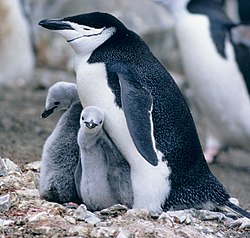This is an old revision of this page, as edited by 209.106.1.250 (talk) at 19:16, 12 March 2007 (→Systematics and evolution). The present address (URL) is a permanent link to this revision, which may differ significantly from the current revision.
Revision as of 19:16, 12 March 2007 by 209.106.1.250 (talk) (→Systematics and evolution)(diff) ← Previous revision | Latest revision (diff) | Newer revision → (diff) For other uses, see Penguin (disambiguation).
| Penguins Temporal range: Paleocene-Recent | |
|---|---|

| |
| Chinstrap Penguin, Pygoscelis antarctica | |
| Scientific classification | |
| Kingdom: | Animalia |
| Phylum: | Chordata |
| Class: | Aves |
| Order: | Sphenisciformes Sharpe, 1891 |
| Family: | Spheniscidae Bonaparte, 1831 |
| Modern genera | |
| |

Penguins (order Sphenisciformes, family Spheniscidae) are a group of aquatic, flightless birds living almost exclusively in the Southern Hemisphere.
The number of penguin species has been and still is a matter of debate. Depending on which authority is followed, biodiversity varies between 17 and 20 living species, all in the subfamily Spheniscinae. Some sources consider the White-flippered Penguin a separate Eudyptula species, while others treat it as a subspecies of the Little Penguin (e.g. Williams, 1995; Davis & Renner, 2003); the actual situation seems to be more complicated (Banks et al. 2002). Similarly, it is still unclear whether the Royal Penguin is merely a color morph of the Macaroni penguin. Also possibly eligible to be treated as a separate species is the Northern population of Rockhopper penguins (Davis & Renner, 2003). Although all penguin species are native to the southern hemisphere, they are not, contrary to popular belief, found only in cold climates, such as Antarctica. In fact, only a few species of penguin actually live so far south. Three species live in the temperate zone; one lives as far north as the Galápagos Islands (the Galápagos Penguin).
The largest living species is the Emperor Penguin (Aptenodytes forsteri): adults average about 1.1 m (3 ft 7 in) tall and weigh 35 kg (75 lb) or more. The smallest penguin species is the Little Blue Penguin (also known as the Fairy Penguin or the Blue Penguin), which stands around 40 cm tall (16 in) and weighs 1 kg (2.2 lb). Generally larger penguins retain heat better, and thus inhabit colder regions, while smaller penguins are found in temperate or even tropical climates (see also Bergmann's Rule). Some prehistoric species attained enormous sizes, becoming as high or as heavy as an adult human; see below for more.
Most penguins feed on krill, fish, squid, and other forms of sealife caught while swimming underwater. They spend half of their life on land and half in the oceans.
Penguins seem to have no fear of humans and have approached groups of explorers without hesitation. This is probably on account of there being no land predators in Antarctica or the nearby offshore islands that prey on or attack penguins. Instead, penguins are at risk at sea from predators such as the leopard seal.
A new study by MIT released in January of 2007, found that 80% of penguins were left handed. The findings concluded that penguins use their dominant flipper for everything from building nests to moving other penguins out of the way.
Anatomy
Penguins are superbly adapted to an aquatic life. Their wings have become flippers, useless for flight in the air. In the water, however, penguins are astonishingly agile. Within the smooth plumage a layer of air is preserved, ensuring buoyancy. The air layer also helps insulate the birds in cold waters. On land, penguins use their tails and wings to maintain balance for their upright stance.
All penguins are countershaded - that is, they have a white underside and a dark (mostly black) upperside. This is for camouflage. A predator looking up from below (such as an orca or a leopard seal) has difficulty distinguishing between a white penguin belly and the reflective water surface. The dark plumage on their backs camouflages them from above.
Diving penguins reach 6 to 12 km/h (3.7 to 7.5 mph), though there are reports of velocities of 27 km/h (17 mph) (which are more realistic in the case of startled flight). The small penguins do not usually dive deep; they catch their prey near the surface in dives that normally last only one or two minutes. Larger penguins can dive deep in case of need. Dives of the large Emperor Penguin have been recorded which reach a depth of 565 m (1870 ft) and last up to 22 minutes.
Penguins either waddle on their feet or slide on their bellies across the snow, a movement called "tobogganing", which allows them to conserve energy and move relatively fast at the same time.
Penguins have an excellent sense of hearing. Their eyes are adapted for underwater vision, and are their primary means of locating prey and avoiding predators; in air, conversely, they are nearsighted. Their sense of smell has not been researched so far.
They are able to drink salt water safely because their supraorbital gland filters excess salt from the bloodstream. The salt is excreted in a concentrated fluid from the nasal passages.
Mating habits
Some penguins mate for life, others for just one season. They generally raise a small brood, and the parents cooperate in caring for the clutch and for the young. During the cold season on the other hand the mates separate for several months to protect the egg. Usually, the male stays with the egg and keeps it warm, and the female goes out to sea and finds food so that when it comes home, the baby will have food to eat. Once the female comes back, they switch roles. Not all mating pairs of penguins are male and female. When mothers lose a chick, they sometimes attempt to "steal" another mother's chick, usually unsuccessfully as other females in the vicinity assist the defending mother in keeping her chick. As the young grow, they assemble in large groups called crèches in some species, such as Emperor Penguins.
Name
Penguin is thought by some to derive from the Welsh words pen (head) and gwyn (white), applied to the Great Auk, which had a conspicuous white patch between the bill and the eye (although its head was black), or from an island off Newfoundland known as "White Head" due to a large white rock. This may be, however, a false etymology created by Dr. John Dee in his book on Prince Madoc of Wales, supposedly one of the discoverers of America. By this Dee hoped to cement Queen Elizabeth I's claim, as a Tudor, to the New World. Penguins live nowhere near Newfoundland, nor do they generally have white heads, but they do look remarkably like Great Auks in general shape.
According to another theory, the original name was pen-wing, with reference to the rudimentary wings of both Great Auks and penguins. A third theory is that penguin comes from the Latin pinguis (fat). This has added credibility because in two other Germanic languages, Dutch 'pinguïn' and German, 'Pinguin' both have the 'i' vowel too. While it has been replaced by an 'e' in the English spelling, it can still be heard. By simply looking at the word's pronunciation and comparing that to the Dutch and German words, one could assume a common Latin root - after the first Germanic sound shift (500-200 BC) that makes a PIE 'p' into a 'f'. However, a Welsh 'i' is often sound-shifted to an 'e' in the English language, so a Welsh origin cannot be dismissed.
Penguins in popular culture

Penguins are popular around the world, primarily for their unusually upright, waddling pace and (compared to other birds) lack of fear of humans. Their striking black and white plumage is often likened to a tuxedo suit and generates humorous remarks about the bird being "well dressed". Perhaps in reaction to this cutesy stereotype, fictional penguins are occasionally presented as grouchy or even sinister. Penguins have also been the subject of many books and documentary films.
Gallery of living species
-
 Emperor Penguins
Emperor Penguins
Aptenodytes forsteri -
 King Penguins
King Penguins
Aptenodytes patagonicus -
 Adelie penguins
Adelie penguins
Pygoscelis adeliae -
 Chinstrap Penguin (Pygoscelis antarctica) hunting for krill
Chinstrap Penguin (Pygoscelis antarctica) hunting for krill
-
 Gentoo Penguin
Gentoo Penguin
Pygoscelis papua -
 Southern Rockhopper Penguin
Southern Rockhopper Penguin
Eudyptes chrysocome -
 Fiordland Penguin
Fiordland Penguin
Eudyptes pachyrhynchus -
 Snares Penguin
Snares Penguin
Eudyptes robustus -
 Macaroni Penguin
Macaroni Penguin
Eudyptes chrysolophus -
 Yellow-eyed Penguin
Yellow-eyed Penguin
Megadyptes antipodes -
 Little Penguin or Fairy Penguin
Little Penguin or Fairy Penguin
Eudyptula minor -
African Penguin or Jackass Penguin Spheniscus demersus
African Penguin or Jackass Penguin
Spheniscus demersus -
 Galapagos Penguins
Galapagos Penguins
Spheniscus mendiculus -
 Humboldt Penguin (Spheniscus humboldti) at the Milwaukee County Zoological Gardens
Humboldt Penguin (Spheniscus humboldti) at the Milwaukee County Zoological Gardens
-
 Magellanic Penguin
Magellanic Penguin
Spheniscus magellanicus
References
- Acosta Hospitaleche, Carolina (2004): Los pingüinos (Aves, Sphenisciformes) fósiles de Patagonia. Sistemática, biogeografía y evolución. Doctoral thesis, Department of Natural Sciences and Museum, Universidad Nacional de La Plata. La Plata, Argentina. PDF fulltext
- Baker, Allan J.; Pereira, Sergio Luiz; Haddrath, Oliver P. & Edge, Kerri-Anne (2006): Multiple gene evidence for expansion of extant penguins out of Antarctica due to global cooling. Proc. R. Soc. B 273: 11-17. doi:10.1098/rspb.2005.3260 PDF fulltext
- Banks, Jonathan C.; Mitchell, Anthony D.; Waas, Joseph R. & Paterson, Adrian M. (2002): An unexpected pattern of molecular divergence within the blue penguin (Eudyptula minor) complex. Notornis 49(1): 29–38. PDF fulltext
- Bertelli, Sara & Giannini, Norberto P. (2005): A phylogeny of extant penguins (Aves: Sphenisciformes) combining morphology and mitochondrial sequences. Cladistics 21(3): 209–239. doi:10.1111/j.1096-0031.2005.00065.x (HTML abstract)
- Clarke, Julia A.; Olivero, Eduardo B. & Puerta, Pablo (2003): Description of the earliest fossil penguin from South America and first Paleogene vertebrate locality of Tierra Del Fuego, Argentina. American Museum novitates 3423: 1-18. PDF fulltext
- Davis; Lloyd S. & Renner; M. (1995). Penguins . London: T & A D Poyser. ISBN 0-7136-6550-5
- Fain, Matthew G. & Houde, Peter (2004): Parallel radiations in the primary clades of birds. Evolution 58(11): 2558-2573. doi:10.1554/04-235 PDF fulltext
- Jadwiszczak, Piotr (2006): Eocene penguins of Seymour Island, Antarctica: taxonomy. Polish Polar Research 27(1), 3–62. PDF fulltext
- Ksepka, Daniel T., Bertelli, Sara & Giannini, Norberto P. (2006): The phylogeny of the living and fossil Sphenisciformes (penguins). Cladistics 22(5): 412–441. doi:10.1111/j.1096-0031.2006.00116.x (HTML abstract)
- Marples, B. J. (1962): Observations on the history of penguins. In: Leeper, G. W. (ed.), The evolution of living organisms. Melbourne, Melbourne University Press: 408-416.
- Mayr, G. (2005): Tertiary plotopterids (Aves, Plotopteridae) and a novel hypothesis on the phylogenetic relationships of penguins (Spheniscidae). Journal of Zoological Systematics and Evolutionary Research 43(1): 61-71. doi:10.1111/j.1439-0469.2004.00291.x PDF fulltext
- Slack, Kerryn E.; Jones, Craig M.; Ando, Tatsuro; Harrison G. L. "Abby"; Fordyce R. Ewan; Arnason, Ulfur & Penny, David (2006): Early Penguin Fossils, plus Mitochondrial Genomes, Calibrate Avian Evolution. Molecular Biology and Evolution 23(6): 1144-1155. doi:10.1093/molbev/msj124 PDF fulltext Supplementary Material
- Williams; Tony D. (1995). The Penguins - Spheniscidae . Oxford: Oxford University Press. ISBN 0-19-854667-X
Footnotes
- "Animal Fact Sheets". Retrieved 2006-07-21.
- "Humboldt Penguin :: Saint Louis Zoo". Retrieved 2006-07-21.
- "African Penguins and Penguins of the World". Retrieved 2006-07-21.
- "Columbia News Service: June 10, 2002: They're in love. They're gay. They're penguins... And they're not alone". Retrieved 2006-07-21.
- "365gay.com: Gay Penguins Resist 'Aversion Therapy'". Retrieved 2006-07-21.
External links
- penguinpage.net - Weblog covering ongoing research in NZ penguins
- Penguin information on 70South
- Gentoo penguin webcam from the Antarctic
- Information about penguins at pinguins.info
- PBS Nature: The World of Penguins
- Integrated Taxonomic Information System
- Seaworld Penguin Information
- Penguin Weblog
- Pictures Penguins
- Penguin Videos on the Internet Bird Collection
- Penguin World
Template:Link FA Template:Link FA
Categories: